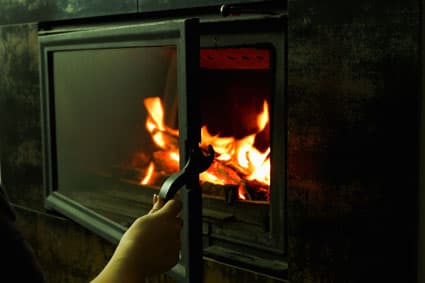
What goes on within the interior of your chimney? It’s hard to decipher the actual condition of your chimney unless it tells you through drafting issues that often manifest in the form of smoke and odor. Having your chimney inspected will alert you if there’s anything amiss within your chimney system, including the true condition of its masonry.
But what about your appliance liner? What should you know about liners and how they affect the masonry of your chimney?
Chimney Liners & Their Function
There are a few things you should learn about your chimney and its anatomy outside of a chimney inspection, as this information can help you make an informed decision should you need to replace or purchase a new liner, how to take care of your current liner, and the function it serves.

Chimney liners serve three distinct purposes: they protect your home, your chimney’s masonry, and helps promote optimal efficiency of your fireplace.
Protects Your Home
There’s a reason why chimney liners exist and that’s to prevent the heat within the chimney from catching your home on fire. In tests conducted by the National Bureau of Standards (NBS), chimneys without liners allowed the heat of a fire to move through them so fast that it only took 3-1/2 hours for the neighboring woodwork to catch fire.
In reality, a chimney is incomplete without a liner and won’t meet standards and regulations. Chimney fires are extremely dangerous and remain a highly probable outcome if you don’t take care of your chimney or properly equip it.
For real estate and housing contract purposes, you’ll want to have a liner in your chimney or else you may not be able to sell your home. Many realtors require that a chimney inspection be conducted during the buying or selling of a home, otherwise a chimney fire could occur causing damages or bodily harm. Having a liner in the chimney and having that chimney be professionally inspected will cover all of your bases.
Protects the Masonry of Your Chimney
The chimney liner is there to not just protect your home, but the chimney’s masonry as well. The liner is an extra layer that defends the integrity of the masonry against dangerous and corrosive byproducts of combustion.

In tests conducted by the NBS, results showed that flue gases were able to easily penetrate through the brick and mortar. When this penetration occurred, the lifespan of the chimney was dramatically reduced. This is because flue gases are acidic in their nature and will erode away the physical objects they come into contact with, like the chimney’s mortar joints that are found inside of the chimney.
When mortar joints erode due to their exposure to the flue gases, the heat will transfer more rapidly. The result can be dangerous and sometimes deadly: combustibles and hazardous gases like carbon monoxide can leak into places they shouldn’t be, like the living spaces of your home.
Encourages Optimal Efficiency
Appliances like a wood stove or furnaces need the right flue size to perform. The chimney has the dual purpose of acting as a passageway that allows combustion byproducts to exit the home safely as well as creating a draft to push these gases outside.
If your chimney has a liner that’s not the right size or doesn’t have one at all, the byproducts can’t be carried by the draft. It could also lead to your wood-burning stove having an excessive amount of creosote buildup, which can be dangerous if it goes unchecked.
Types of Liners
There are different types of liners, each with their own set of advantages and disadvantages. However, by having a liner, you’ll keep your chimney and your home intact.
Clay: the most common style of chimney liner, clay is inexpensive and easily accessible for an anytime-install. It doesn’t absorb heat rapidly with extreme temperature shifts (like a chimney fire), so in this event, the clay tile could crack and split. That’s why it’s important to care for your chimney and prevent fires from occurring.

Cast-in-place: this material is cement-like, making for a lightweight liner that seamlessly protects your chimney from gases. Cast-in-place liners can be helpful for older chimneys in that they aid in boosting their structural integrity, but they’re costly and challenging to install.
Metal: another common liner material is metal. Metal chimneys, made of aluminum or steel, help repair and upgrade existing chimneys. These liners are safe and extremely durable, but they are more expensive than clay liners.
Chimney Masonry and Your Liner
Your liner is there to protect your chimney. Your liner also protects your home from things like combustion byproducts, chimney fires, deadly carbon monoxide poisoning, and creosote buildup. By having a liner in place, you’ll not only protect the masonry, but ensure the longevity of your chimney’s lifespan.
When it comes to chimney inspection and sweeping, the #1 company in Chicago and Suburbs is Vertical Chimney Care. We have helped thousands of homeowners with cleaning out the flue of the chimney and removing the creosote. In return, many homeowners have recommended our services to their friends and family. Contact us to speak to a specialist today.
